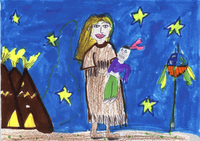
Book Review: The Legend of the Bluebonnet
NOTE: This review was created for a class at TWU
drawing by Natalie R. from spaghetticlub.com
1. BIBLIOGRAPHY
DePaola, Tomie. THE LEGEND OF THE BLUEBONNET. New York, NY: G.P. Putnam's Sons. ISBN 0399224114
2. PLOT SUMMARY-
In a retelling of an old Comanche tale, we learn of the origin of the state flower of Texas, the bluebonnet. After a long drought, the Comanche ask the Spirits what to do and receive the answer that they must make a burnt offering of their most prized possession. No one in the tribe is willing to make this sacrifice, except for She-Who-Is-Alone. The young girl, who has lost her whole family, gives up the last tie to that family, a warrior doll with blue feathers. After making her sacrifice, she falls asleep and awakens to find the hillside covered in blubonnets and a warm rain falling. The tribe gives thanks and renames her One-Who-Dearly-Loved-Her-People.
3. CRITICAL ANALYSIS
Tomie DePaola's retelling of the Comanche tale in THE LEGEND OF THE BLUEBONNET is an excellent example of both traditional and multicultural literature. It is a classic "porquoi tale," explaining the appearance of bluebonnets each spring. Like most traditional stories, it requires us to suspend our disbelief and embrace the universal theme of generosity and sacrifice. DePaola masterfully embeds repetition and the number three into the tale, evoking the sense that it comes from the oral tradition. "For three days," says the narrator, "the dancers danced to the sound of the drums, and for three days, the People called Comanche watched and waited." The sense of oral language is reinforced in poetic line breaks and the use of alliteration such as, "dancers danced," "watched and waited," belt of bone...beautiful blue feathers." THE LEGEND OF THE BLUEBONNET also fosters an awareness of the Comanche people without stereotyping the characters. Since the book is a folktale, the characters are fairly flat, and the plot simple, but the people are shown as both good and bad, selfish and selfless. DePaola uses culturally accurate details in describing the shaman and the dress of the girl's warrior doll. Beautifully illustrated in DePaola's signature simple, soft style, THE LEGEND OF THE BLUBONNET is a must-read for any resident of Texas and any fan of folktales.
4. REVIEW EXCERPT(S)
Children's Literature: "Tomie dePaola provides a charming retelling of the Native American legend about the origin of Texas' state flower, the bluebonnet."
Spaghetti Book Club: "I recommend this book for everyone because it teaches you about giving up something that is important. I think students of all ages can enjoy this book and learn about sharing." (Natalie R., age 9)
5. CONNECTIONS
*For older students, use THE LEGEND OF THE BLUEBONNET to study female voices in picture books. Examples: McKissack, Patricia C. GOING SOMEPLACE SPECIAL, and Paul, Ann Whitford. ALL BY HERSELF
See also the following website for ideas:
http://www.scils.rutgers.edu/%7ekvander/Feminist/fempic.html
*Create a unit around the children of Indian folklore using books such as FIRST SALMON by Roxane Beauclair Salonen and Cynthia Rylant's LONG NIGHT MOON. Themes can include the importance of ritual in our lives, the importance of nature and giving back to the earth. Would be a great tie-in for Earth Day.
*Read and compare DePaola's other legends of flowers - THE LEGEND OF THE INDIAN PAINTBRUSH and THE LEGEND OF THE POINSETTIA. Use the books as a springboard for creating a classroom garden or for studying the native flowers of Texas.

No comments:
Post a Comment